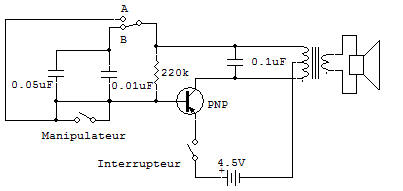
Capacitors in Series and Parallel

Capacitors might be the handiest items. They can store electricity, smooth out pulsing electricity into a steady flow and let alternating current (AC) flow while blocking direct current (DC).
This Project will let you hear the effects of capacitors in series and parallel.
When you finish wiring this Project, set the Select Switch to B. Next put power ON. You'll hear a sound from the Speaker. In this case electricity is flowing through 0,01 uF capacitor (refer to the schematic while we talk about this).
Now press the Key. What happens?
You'll hear a lower-pitched sound from the Speaker. This is because the 0.05uF capacitor has been added in parallel to the first. What do you think happens to the total capacitance when you connect two capacitors in parallel?
You may have guessed wrong. When Two capacitors are connected in parallel, the total capacitance increases!
CT = C1 + C2 + … + CN
Now release the Key and set the Select Switch from B to A ... what do you hear?
Do not press the Key while Select Switch is set to A (the transistor may be damaged). You'll hear a high-pitched sound from the Speaker. This is because 0.05 uF and 0.01 uF capacitors are now connected in series and that means the total capacitance in the circuit is now less than the smallest capacitor making up the series connection.
CT = 1/C1 + 1/C2 + … + 1/CN
You can see now that connecting capacitors in series and parallel has the opposite effect of connecting resistors in the same way.
Be careful — it's easy to get confused about which one increases or decreases. You're probably wondering when we're going to get around to telling you what AC and DC are ... well do it sometime, but not now. But why not try to figure it out yourself?
Be sure to keep a note of your guess so you can see how close you came...
